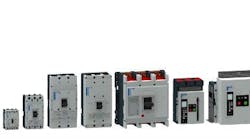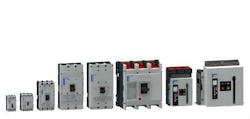Eaton’s Power Defense molded case circuit breaker adds connectivity and intelligence
Eaton's Power Defense molded case circuit breaker (MCCB) has broken the mold by adding connectivity and intelligence to one of the most common electrical devices.
A circuit breaker’s useful life varies greatly, depending on many factors. The harsh conditions in a mining operation might shorten a circuit breaker’s life to mere months. But it’s not uncommon to find factories with banks of them in use for decades.The key distinction is whether that breaker is performing properly, which can be determined through time-based testing by maintenance technicians or via the circuit breaker’s ability to test itself and report its condition. And, as long as it’s talking, why not ask the breaker for information about power usage?
Power management company Eaton has a long history in the electrical industry, explains Robert Griffin, product line manager at Eaton. “Circuit protection is part of our DNA,” he says. “We’re turning circuit breakers into something that adds more value, adds more knowledge and provides additional safety benefits. Practically everything in the electrical distribution system has a circuit breaker in it. Why not leverage that device in your system to provide power and energy data?”
Eaton’s Power Defense molded case circuit breaker (MCCB) has broken the mold by adding connectivity and intelligence to one of the most common electrical devices. The payoff is higher-level metering and predictive diagnostics in a foundational electrical-system component. Eaton’s breaker-health algorithm is designed to weigh data on multiple conditions to predict device failure before it occurs.
“Everyone within the industry wants to generate data and be able to analyze it,” says Jim Lagree, chief engineer at Eaton. “We’re not just generating data to do analytics; we’re doing the analytics within the breaker, taking it from data to actionable knowledge. A significant amount of data is being processed in the unit to say you have this much of the useful life of your breaker left.”
Griffin further explained, “We know that maintenance is critical for the safe operation of circuit breakers, and, with the advancements offered by Power Defense and the breaker-healthalgorithm, we can now avoid guesswork or time-based maintenance approaches and proactively know when maintenance is required.”
Bigger picture
Power Defense circuit breakers provide multiple communications options, energy metering and health algorithms that deliver data about the circuit breaker, broader power distribution system and overall energy usage. Its trip units monitor and report current, voltage, harmonics, power and energy consumption, while also providing waveforms and other information to analyze safety and power availability of the connected system.
Power Defense circuit breakers are designed to communicate what type of fault caused the breaker to trip, as well as capturing waveforms before and after the tripping event to help to diagnose system conditions. “We can go back and look at these waveforms to determine what caused the tripping, which allows technicians to restore power more quickly” explains Lagree.
Talk to me
“We’ve had communications in our circuit breakers since the early 1980s,” explains Lagree. “Whether it was serial-based or it’s now Ethernet, communication has been there. The cost has come way down, so there are more capabilities. In the old days, it was a large card that you couldn’t fit inside a circuit breaker. We’ve built in faster communications capability. In the 1980s, it took a long time to transfer all of that data. Now, it’s just in the blink of an eye. We’re adding more information and more data to analyze and tell the customer more about what’s happening with the circuit protection.”
Power Defense MCCBs offer the ability to communicate on two different channels at the same time. “One channel is a dedicated Modbus RTU for the simplest type of applications,” explains Lagree. “Then there’s a communication adaptor module with a variety of protocols, including Ethernet to Modbus TCP/IP. It also has HTML5 capability, so it can publish to a Web page. And we have Profibus. What we’re leveraging is the ability of this module to adapt in the future.” A gateway capability also is available for Modbus TCP/IP, BACnet and email notification of alarms, and it’s hardened and updated to prevent the latest cybersecurity threats.
“We’ve learned to be flexible,” says Griffin. “Whether you’re working in an automation system or you’re in another process where it might have Profibus or Profinet, it’s best to have the common-denominator capability that’s flexible enough to meet the different protocols. We can run Modbus RTU as a native system or Ethernet, or we can do Profibus. And we’ll have more modules that meet these protocols as we go along.”
Furthermore, for end users that don’t make use of communications in their power systems, the Power Defense circuit breakers can still communicate critical system conditions or parameters to control systems through the use of available programmable relays. “There are one to three optional programmable relays that can be included in the circuit breaker,” says Griffin. “You can program the relay to close when the breaker reaches, let’s say, 25% of its life.” Almost 30 different alarm values can be programmed onto the relay and sent to an alarm stack light or fed into a PLC.
Added value
MCCBs provide functionality in almost all low-voltage applications, protecting devices from overloads and short circuits. Many facilities use hundreds of these devices, offering an opportunity to generate data that can be leveraged not only to monitor the breaker’s health, but to optimize energy usage. “By upgrading existing circuit breakers to Power Defense technology, you’re able to get more functionality, including metering, from the circuit breaker without adding components into the system.”
Traditional thermal magnetic breakers are designed to protect people and equipment from overcurrent or electrical overloads, but they don’t provide data on what type of fault or the magnitude, says Griffin. Power Defense circuit breakers provide more visibility into the fault, capturing a wide variety of data about the event. “On the front of the breaker, there’s a series of LED lights that can tell you what type of event it was—a short circuit fault; a ground fault; or an overload fault,” explains Griffin. “You can now go into the breaker and look at detailed information about what caused the fault, when that fault occurred and what the settings were at that time. You can troubleshoot the condition and get your system corrected faster.”
Platform edge
The Power Defense technology incorporates Eaton’s Arcflash Reduction Maintenance System and Zone Selective Interlock (ZSI) technology for advanced safety. Eaton’s Arcflash Reduction Maintenance System technology is designed to reduce dangerous incident energy levels and can be activated either locally or remotely by personnel, while ZSI helps to protect equipment by intelligently selecting faster trip times depending upon the location of the fault. The Power Defense circuit breakers enable personnel to perform ZSI system testing with visual status indication to improve productivity and provide peace of mind that systems are operating as designed.
“Arc flash hazards have been identified as one of the most dangerous occurrences in electrical power systems,” explains Lagree. “More than 10 years ago, Eaton pioneered the Arcflash Reduction System technology. It’s a dedicated circuit to trip the breaker as fast as it can. That’s the best available way to reduce the amount of energy the arc flash creates.”
ZSI has been around for quite some time, says Griffin. “With Power Defense, we provide the opportunity to test that the ZSI system is working, along with the visual indication that the system is properly connected and working,” he explains.
The Power Defense platform meets a variety of industry standards, including applicable UL, International Electrotechnical Committee (IEC), China Compulsory Certificate (CCC) and Canadian Standards Association (CSA).
For more information visit Eaton.com and search for Power Defense.
Latest from Asset Management

Leaders relevant to this article:




